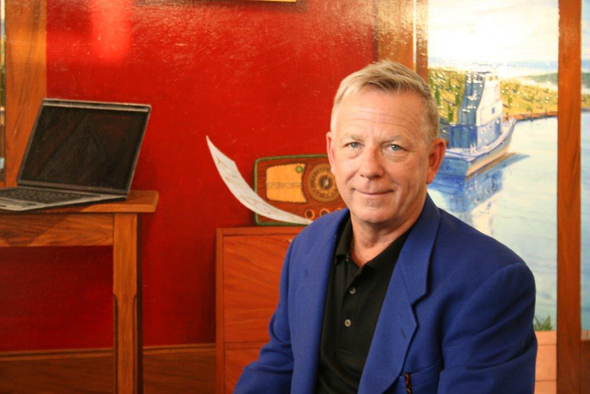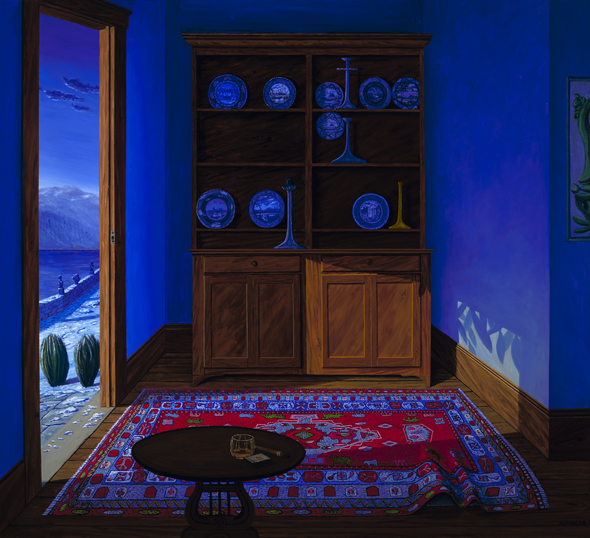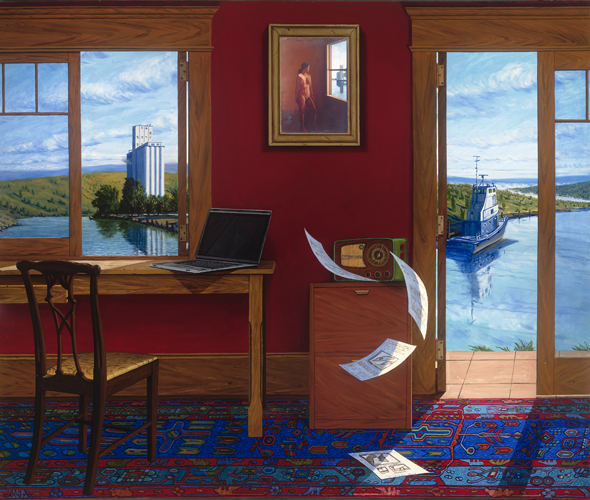Artist Profile

Artist Kevin Kearney paints tangible reveries. A successful contractor who’s built myriad homes, Kearney ’s paintings play out in sumptuous, architecturally accurate rooms. While often extravagant and antiqueladen, the spaces he renders in his art offer cozy touches a dog, a disheveled rug. The viewer can imagine herself seated on Kearney ’s ornately depicted sofas, peering outside where the view is more whimsical. And whether the view makes you fearful or thrilled, the painting puts you at ease because you ’re inside of Kearney ’s home. This allows the rooms in the pieces to serve as an elegant vehicle for exploring the fantasy out the window; an ornate, sturdy perch for engaging with the world.
Growing up in a working class neighborhood in the rough part of Baltimore, Kearney pursued his lifelong passion from an early age; friends in his street gang even nicknamed him Van Gogh. With encouragement from his father, Kearney enrolled in the art program at Calvert Hall High School and supplemented his talent with skills. He entered the Maryland Institute College of art in 1970 and was immediately at home in the world of fine art. In 1977 received his MFA the University of California at Davis and moved to San Francisco.
He pursued a career in art for two decades with modest strides before the fear of failure set in. In 1992, he put down his brushes and focused on his family and his construction business, Kearney and O’Banion Inc.
It wasn’t until an inspirational visit to the Metropolitan Museum of Art in 2013 that he returned to his easel, painting several large pieces in just months while continuing to work 60 hour weeks. It was a second wind, years deferred. He’d felt that his technical skills as well as the clarity of his vision had returned better than before.
Kearney was proven correct. Just two years later he was discovered by a new patroness, Marlene Porsche. For the first time in his life, he’s considering putting his successful construction business aside, and focusing solely on his craft. On September 21, Porsche will host Vernissage, an exhibition for Kearney in her private museum in Zurich, Switzerland with the goal of gaining him acceptance into the higher spheres of the fine art world. www.kevinkearney.org

You started painting and pursued its mastery from a young age what was it like to be an art student growing up in a working class neighborhood with gangs?
I was very lucky to have grown up in a world where my father thought pursuing art was a noble profession. But as I grew into adolescence the boys in my working class neighborhood all began to hang out at the newly built “Alameda Shopping Center,” in northern Baltimore. We all lived in brick row houses built for the returning GI’S after WWII. By age 13 I was indoctrinated and passed the test to become a member of the second generation of “The Alameda Sports and Pleasure Club.” After school we all met at the local Woolworth soda fountain and on Friday and Saturday nights met at the Alameda Pharmacy and always managed to get a local “smoke” to buy us six cases of beer and a bottle or two of bourbon. If that didn’t pan out we just stole the liquor we needed to get”lit”. Then we went drinking in the woods behind the shopping center or next to Saint Matthews Catholic Church. Once high we raised havoc throughout our turf.
I was aware that most of my friend’s parents frowned on art, but my father despite his diagnosed paranoid schizophrenia encouraged me to paint.
Could you please describe the moment you found your style?
I was in my third year of art school and living in a rundown area of Baltimore called Fells Point. It was home to most of John Water’s (director of Pink Flamingos and Female Trouble) actors and camera crews as well as many Baltimore painters and sculptors. I decide to take my French easel out and paint en plein air in an industrial part of the city along the waterfront.
I found a street I liked and painted it on the left (side of the canvas), and then walked five blocks away and found another street and painted it (on the right side of the canvas). I went back to my studio and invented the house in the middle and loved the image. I knew as soon as I completed “Two Streets” it that it had a singular voice and that was mine. From that point on I never had to force trying to find my way artistically. I knew from my study of art that painting could be a very personal form of expression. If an artist was allowed to develop the technical skills in drawing and painting his or her individual voice could emerge.

What was your early work like compared to today?
I’ve evolved a more striking and detailed style using primary rich colors against which my purposely vague narratives play out. I have always thought a good painting should pose questions and have images that allow the viewer to enter a painting and be provoked by his own memories and emotions. That is what I want art to do for me. I also don’t want to have to explain what I am painting. I will quote Lucian Freud on this same question. When asked why he painted the images he did he answered. “If I knew I wouldn’t paint anymore?”
As a successful contractor, what are the details about a room that excite you? What makes you want to put chair or rug into your painting?
I can’t explain the images I paint and why I am drawn to them. I know I have never seen anything like my new paintings. I just trust my intuition after having been making art for fifty years!
Text by Valerie Demichera

